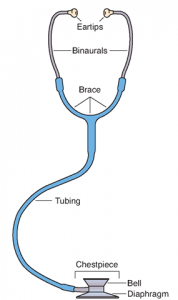Understanding how and when it is appropriate to use definitions is a critical skill in technical writing. Through this assignment the three types of definitions, parenthetical, sentence and expanded, were explored by explaining the term “stethoscope.”
A PDF version can be found here.
Introduction
Criteria
Students are required to choose a relatively complex term that is relevant in their profession or field of work. Types of definitions will be explored through composing a parenthetical, sentence and an expanded definition of the chosen term. It is expected students will choose a specific situation and target audience including non-technical readers to direct the explanation to. The students will need to consider the selected audience to determine the appropriate tone and language used in the definitions.
Objective
Through completion of this assignment students will gain appreciation of the importance and role of definitions in technical writing. By identifying the target audience, the purpose and the need for a definition can be determined. Finally, students will be able to differentiate the levels of definitions and be able to choose the appropriate level according to the situation.
Stethoscope
The Audience
This explanation of the stethoscope will be directed to students in the ENGL 301 technical writing course who may or may not have experience with this instrument in the medical field.
Parenthetical Definition
During a physical examination, a stethoscope (medical instrument for internal sounds) may be used to aid in assessing the lungs and abdomen.
Sentence Definition and Expanded Definition
A stethoscope is a medical instrument that allows for internal sounds, such as the heart beat and breathing sounds, to be made audible. Typically used by physicians, the stethoscope is a critical tool when examining a patient. This tool allows for a quick snapshot of what is occurring within the body, allowing the physician to formulate a treatment plan quickly. Heart murmurs, irregular patterns of heart beat and lung ailments can be quickly determined by using a stethoscope. Generally, it is thought that stethoscopes are only useful for making heart and lung sounds audible but there are other applications to consider. For example, gut motility can be assessed through audition of abdominal sounds. This is particularly useful in veterinary medicine when working with cattle such as diagnosing intestinal twists solely by listening.
Modern stethoscopes have two eartips compared to the first stethoscopes used which were intended for use in one ear only. The eartips are connected through hollow tubing called a brace which join to a single tube leading to the chestpiece. The chestpiece can vary in shape depending on the type of sound being listened to. High frequency sounds can be heard using a bell shaped chestpiece while listening to low frequency sounds is best heard with a flat chestpiece. Modern chestpieces are also available with both shapes that allow the user to flip between the bell and the flat eliminating the need for multiple stethoscopes.
Works Cited
Layton, J. (2013). How Stethoscopes Work. Retrieved on September 24, from http://science.howstuffworks.com
Seacrest, R. (1994). How Products are Made. Retrieved on September 24, 2016, from Encyclopedia.com
Wondering how do stethoscopes work? (n.d). Dmelibrary. Retrieved on September 24, 2016, from http://dmelibrary.com/how-do-stethoscopes-work/

